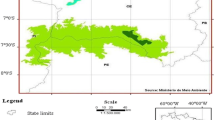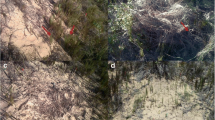Abstract
Commercialisation often increases the difficulty in managing harvested plant populations sustainably. The bark of the popular medicinal species, Warburgia salutaris (Bertol.f.) Chiov. (Canellaceae) (‘pepper-bark tree’), is widely traded throughout southern Africa. The impact of commercial harvesting on this Red Data species was assessed by comparing commercially harvested populations with populations growing on private land or in protected areas (termed ‘protected populations’) in Mpumalanga and Limpopo Province, South Africa. The basal diameters and heights of stems in commercially harvested populations were significantly lower than those of the protected populations. The density of young/small plants was low in all populations. W. salutaris is usually resilient to high levels of bark harvesting. In this study, 75% of heavily harvested stems (>10% of the stem below 2 m) coppiced (resprouted). However, individuals that had been affected by regular fires, or repeatedly harvested, appeared prone to a fungal disease and had high percentage mortality. The populations occurring on private land appeared the most vigorous. Habitat in one protected area had been reduced through the construction of a dam. In another, small W. salutaris populations exhibited a shrubby growth form, probably due to frequent fires. Our current knowledge for this species supports a global IUCN status of EN A4acd. Plant conservation needs to become a higher priority both within and outside protected areas. Commercially harvested populations should be better managed through improved harvesting techniques and monitoring. Cultivation levels urgently need to be increased. Further research should be conducted on factors limiting regeneration, including the most appropriate fire regime.
Similar content being viewed by others
References
Botha J. 2001. Perceptions of species availability and values of medicinal plants traded in areas adjacent to the Kruger National Park, South Africa. M.Sc. Thesis, University of the Witwatersrand, Johannesburg, South Africa.
Botha J., Witkowski E.T.F. and Shackleton C.M. 2001. An inventory of medicinal plants traded on the western boundary of the Kruger National Park, South Africa. Koedoe 44: 7–46.
Botha J., Witkowski E.T.F. and Shackleton C.M. 2002. A comparison of anthropogenic and elephant disturbance on Acacia xanthoploea (fever tree) populations in the lowveld, South Africa. Koedoe 45: 9–18.
Chandrashekara U.M. and Sankar S. 1998. Ecology and management of sacred groves in Kerala, India. Forest Ecology and Management 112: 165–177.
Church B. and Scott-Shaw C.R. 1999. Recovery plan for Warburgia salutaris. KwaZulu-Natal Nature Conservation Service Internal Report, 26 pp.
Coates Palgrave P. 1990. Trees of Southern Africa. Struik Publishers, Cape Town, South Africa.
Codd L.E. 1976. Warburgia salutaris (Canellaceae). Flora of Southern Africa 22: 40–41.
Cooper K.H. 1985. The conservation status of indigenous forests in Transvaal, Natal and OFS, South Africa. Unpublished report.Wildlife Society of Southern Africa Conservation Division, Durban, South Africa.
Crouch T.E. and Crouch N.R. 2001. Insect infestations on leaves of the ethnomedicinal pepper-bark tree Warburgia salutaris (Canellaceae). Durban Museum Notes 26: 1–5.
Cunningham A.B. 1992. Mithi isiZulu: the traditional medicine trade in Natal/KwaZulu. Master of Social Science Dissertation, University of Natal, Pietermaritzburg, South Africa.
Cunningham A.B. 2000. Ecological footprint of the wooden rhino: depletion of hardwoods for the carving trade in Kenya. People and Plants online. http://rbgkew.org.uk./peopleplants
Cunningham A.B. and Mbenkum F.T. 1993. Sustainability of Harvesting Prunus africana Bark in Cameroon. United Nations Educational, Scientific and Cultural Organisation, ■Author: location (city) of Organisation? Paris, France.
Dlamini T.S. and Dlamini G.M. 2002. Swaziland. In: Golding J. (ed) Southern African Plant Red Data Lists. Southern African Botanical Diversity Network Report No. 14. National Botanical Institute, Pretoria, South Africa, 237 pp.
Dovie D.B.K., Shackleton C.M. and Witkowski E.T.F. 2002. Direct-use values of woodland resources consumed and traded in a South African village. The International Journal of Sustainable Development and World Ecology 9: 269–283.
Drewes S.E., Crouch N.R., Mashimbye M.J., de Leeuw B.M. and Horn M.M. 2001. A phytochemical basis for the potential use of Warburgia salutaris (pepper-bark tree) leaves in the place of bark. South African Journal of Science 97: 383–386.
Farooquee N.A. and Saxena K.G. 1996. Conservation and utilisation of medicinal plants in high hills of the central Himalayas. Environmental Conservation 23: 75–80.
Felhaber T. and Mayeng I. 1999. South African Primary Health Care Handbook. CombiningWestern and Traditional Practices. Copy Cat Communications and Kagiso Publishers, Cape Town, South Africa.
Geldenhuys C.J. and van der Merwe C.J. 1988. Population structure and growth of the fern Rumohra adiantiformis in relation to frond harvesting in the southern Cape forests. South African Journal of Botany 54: 351–362.
Godoy R.A. and Bawa K.S. 1993. The economic value and sustainable harvest of plants and animals from the tropical forest: assumptions, hypotheses and methods. Economic Botany 47: 215–219.
Harper J.L. 1977. Population Biology of Plants. Academic Press, San Diego, California, pp. 599–643.
Hilton-Taylor C. 1996. Red Data List of Southern African Plants. Strelitizia 4. National Botanic Institute, Pretoria, South Africa.
Hilton-Taylor C. 1997. Red Data List of southern African plants. 2.Corrections and additions. Bothalia 27: 195–209.
IUCN 1994. IUCN Red List Categories. Prepared by the Species Survival Commission. IUCN, Gland, Switzerland.
IUCN 2001. IUCN Red List Criteria Review: Draft of the Proposed Changes and Recommendations. Prepared by the Species Survival Commission. IUCN, Gland, Switzerland, 21 pp.
Izidine S. and Bandeira S.O. 2002. Mozambique. In: Golding J. (ed) Southern African Plant Red Data Lists. Southern African Botanical Diversity Network Report No. 14. National Botanical Institute, Pretoria, South Africa, 237 pp.
Johnson D., Scott-Shaw R. and Nichols G. 1995. The pepper bark tree of Zululand. Veld and Flora March: 16.
Kowalski B. and van Staden J. 2001. In vitro cultivation of two threatened South African medicinal trees - Ocotea bullata and Warburgia salutaris. Plant Growth Regulation 32: 223–228.
Knowles L. and Witkowski E.T.F. 2000. Conservation biology of the succulent shrub Euphorbia barnardii, a serpentine endemic of the Northern Province, South Africa. Austral Ecology 25: 241–252.
Lamont B.B., Marsula R., Enright N.J. and Witkowski E.T.F. 2001. Conservation of an exploited wildflower: modelling growing condition, picking intensity and fire interval effects. Biological Conservation 99: 157–168.
Letsela T., Witkowski E.T.F. and Balkwill K. 2003. Plant resources used for subsistence in Tsehlanyane and Bokong in Lesotho. Economic Botany 57: 619–639.
Low A.B. and Rebelo A.G. 1996. Vegetation of South Africa, Lesotho and Swaziland. Department of Environment Affairs and Tourism, Pretoria, South Africa.
Luoga E.J., Witkowski E.T.F. and Balkwill K. 2002. Harvested and standing wood stocks in protected and communal miombo woodlands of eastern Tanzania. Forest Ecology and Management 164: 15–30.
Luoga E.J., Witkowski E.T.F. and Balkwill K. 2004a. Changes in the extent of miombo woodlands in eastern Tanzania related to the institutional framework and tenure of land and resources. Environment, Development and Sustainability (in press).
Luoga E.J., Witkowski E.T.F. and Balkwill K. 2004b. Regeneration by coppicing (resprouting) of miombo (African savanna) trees in relation to land use. Forest Ecology and Management 189: 23–35.
Mander M. 1998. Marketing of Indigenous Medicinal Plants in South Africa. A Case Study in Kwazulu-Natal. Food and Agricultural Organisation of the United Nations, Rome, Italy.
Mapaura A. and Timberlake J.R. 2002. Zimbabwe. In: Golding J. (ed) Southern African Plant Red Data Lists. Southern African Botanical Diversity Network Report No. 14. National Botanical Institute, Pretoria, South Africa, 237 pp.
Marshall N.T. 1998. Searching for a Cure: Conservation of Medicinal Wildlife Resources in East and Southern Africa. Traffic International, Cambridge, UK.
Meffe G.K. and Carroll C.R. 1994. Principles of Conservation Biology. Sinauer Associates, Sunderland, Massachusetts.
Meyer H.A. 1952. Structure, growth and drain in balanced uneven-aged forests. South African Journal of Botany 52: 387–402.
Msekandiana G. and Mlangeni E. 2002. Malawi. In: Golding J. (ed) Southern African Plant Red Data Lists. Southern African Botanical Diversity Network Report No. 14. National Botanical Institute, Pretoria, South Africa, 237 pp.
Pfab M.F. and Witkowski E.T.F. 1999. Contrasting effects of herbivory on plant size and reproductive performance in two populations of the Critically Endangered species, Euphorbia clivicola R.A. Dyer. Plant Ecology 145: 317–325.
Pielou E.C. 1977. Mathematical Ecology. John Wiley and Sons, Inc., New York.
Rao P., Barik S.K., Pandey H.N. and Tripathi R.S. 1990. Community composition and tree population structure in a sub-tropical broad-leaved forest along a disturbance gradient. Vegetatio 88: 151–162.
Schemske D.W., Husband B.C., Ruckelshaus M.H., Goodwillie C., Parker I.M. and Bishop J.G. 1994. Evaluating approaches to the conservation of rare and endangered plants. Ecology 75: 584–606.
Scott-Shaw C.R. 1999. Rare and Threatened Plants of KwaZulu-Natal and Neighbouring Regions. A Plant Red Data Book. KwaZulu-Natal Conservation Service, Pietermaritzburg, South Africa, 182 pp.
Shackleton C.M. 1993a. Demography and dynamics of the dominant woody species in a communal and protected area of the eastern Transvaal lowveld. South African Journal of Botany 59: 569–574.
Shackleton S.E. 1993b. A situation analysis of the woodcraft industry in the Bushbuckridge District of the Eastern Transvaal, with particular reference to resource use. Unpublished Report, Wits Rural Facility, University of the Witwatersrand, Bushbuckridge, South Africa.
Shackleton C.M. 2000. Stump size and the number of coppice shoots for selected savanna tree species. South African Journal of Botany 66: 124–127.
Shackleton C.M., Griffin N.J., Banks D.I., Mavrandonis J.M. and Shackleton S.E. 1994. Community structure and species composition along a disturbance gradient in a communally managed South African savannah. Vegetatio 115: 157–167.
Shackleton S.E., von Maltitz G. and Evans J. 1998. Factors, conditions and criteria for the successful management of natural resources held under a common property regime: a South African perspective. In: Shackleton S.E. and Tapson A. (eds) Proceedings of the Mini-symposium on Common Property Resource Management, 4–5 August, Nylsvlei Nature Reserve, pp. 74–127.
Statistics South Africa 1998. Census 1996. Department of Statistics, Pretoria, South Africa. http:// www.statssa.gov.za
Symmonds R. and Crouch N. 2000. Propagating the pepper-bark tree (Warburgia salutaris): the Silverglen experience. PlantLife 22: 24–26.
Veeman T.S., Cunningham A.B., Kozanayi W. and Maingi D. 2001. The economics of production of a rare medicinal species re-introduced in south-eastern Zimbabwe - Warburgia salutaris. In: Household Livelihoods, Marketing and Resource Impacts. A Case Study of Bark Products in Eastern Zimbabwe. Institute of Environmental Studies Working Paper No. 18, University of Zimbabwe, Harare, Zimbabwe, pp. 71–80.
Walker B.H., Stone L., Henderson L. and Vernede M. 1986. Size structure analysis of the dominant trees in a South African savanna. South African Journal of Botany 52: 397–402.
Wiegand K., Ward D., Thulke H.H. and Jeltsch F. 2000. From snapshot information to long-term population dynamics of Acacias by a simulation model. Plant Ecology 150: 97–114.
Williams V.L., Balkwill K. and Witkowski E.T.F. 2000. Unravelling the commercial market for medicinal plants and plant parts on the Witwatersrand. Economic Botany 54: 310–327.
Wilson B.G. and Witkowski E.T.F. 2003. Seed banks, bark thickness, and changes in age and size structure (1978–1999) of the African savanna tree, Burkea africana. Plant Ecology 167: 151–162.
Witkowski E.T.F., Dahlmann L.A. and Boycott R.C. 2001. Conservation biology of Kniphofia umbrina, a critically endangered Swaziland serpentine endemic. South African Journal of Science 97: 609–616.
Witkowski E.T.F., Knowles L. and Liston R.J. 1997. Threatened plants in the northern provinces of South Africa: case studies and future approaches. In: Hale P. and Lamb D. (eds) Conservation Outside Nature Reserves. Centre for Conservation Biology, University of Queensland, Brisbane, Australia, pp. 446–451.
Witkowski E.T.F., Lamont B.B. and Connell S.J. 1991. Seed bank dynamics of three co-occurring banksias in south coastal Western Australia: plant age, cockatoos, senescence and interfire establishment. Australian Journal of Botany 39: 385–397.
Witkowski E.T.F., Lamont B.B. and Obbens F.J. 1994. Commercial picking of Banksia hookeriana in the wild reduces subsequent shoot, flower and seed production. Journal of Applied Ecology 31: 508–520.
Author information
Authors and Affiliations
Corresponding author
Rights and permissions
About this article
Cite this article
Botha, J., Witkowski, E. & Shackleton, C. The impact of commercial harvesting on Warburgia salutaris (‘pepper-bark tree’) in Mpumalanga, South Africa. Biodiversity and Conservation 13, 1675–1698 (2004). https://doi.org/10.1023/B:BIOC.0000029333.72945.b0
Issue Date:
DOI: https://doi.org/10.1023/B:BIOC.0000029333.72945.b0




